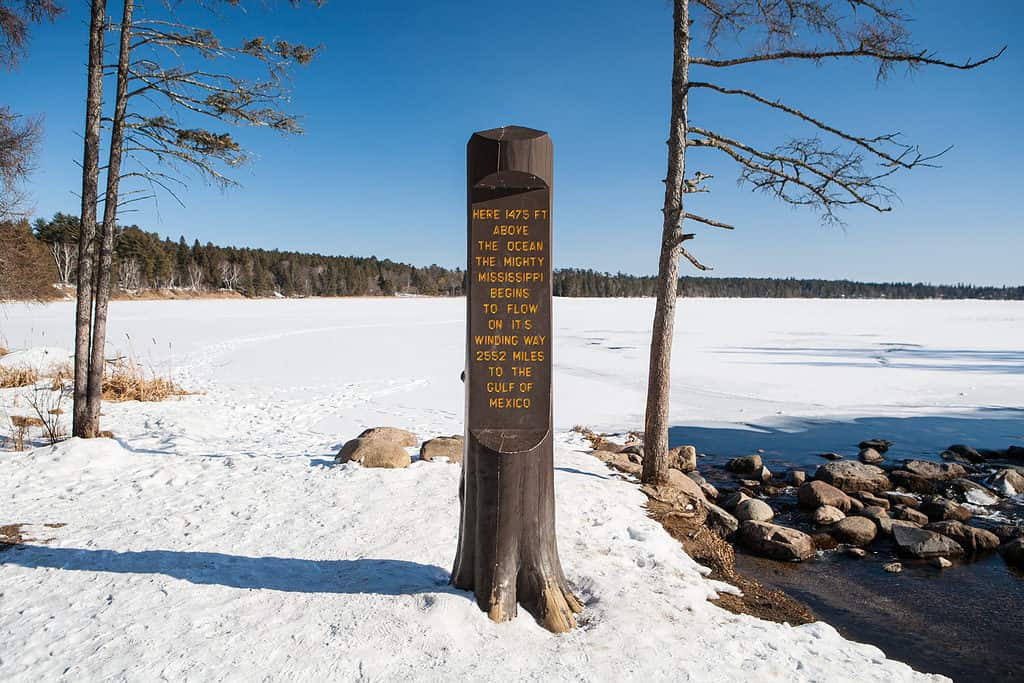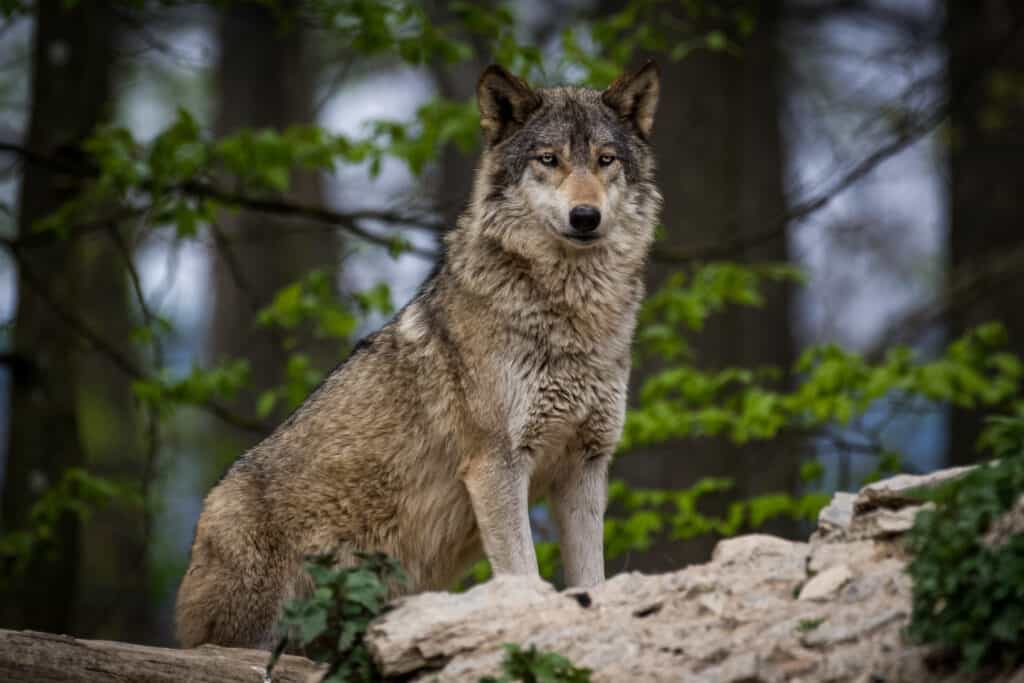The Mississippi River is the second-longest river in North America and the source of endless tales and lore. Many authors and poets have written pieces about the spectacular river. It flows over 2,400 miles before emptying into the Gulf of Mexico. Additionally, the river cuts through 10 different states, so the culture and weather vary significantly along the way. Given that, many wonder what the snowiest place along the Mississippi River is.
The article below answers that very question. And more! It covers some details about the snowiest place along the Mississippi, including things to do in the winter and common wildlife.
Let’s dive in.
What Is the Snowiest Place Along the Mississippi River?
Minnesota is known as the land of a thousand lakes, and it is also the source of the Mississippi River. The source of the Mississippi River is Lake Itasca, in Itasca State Park, Minnesota. And unsurprisingly, this is also the snowiest place along the Mississippi River. Minnesota is well-known for its snowy, bitter-cold winters. Lake Itasca does not disappoint.
Itasca State Park averages 51.6 inches of snow annually. That number is the average annual snowfall over the most recent 30-year history. Thankfully for visitors to Lake Itasca, the cold northern climate means that snow sticks around for some time!

The headwaters of the Mississippi River is in Itasca State Park, at Lake Itasca.
©FiledIMAGE/Shutterstock.com
Where Is Itasca State Park?
Itasca State Park is in the northern part of Minnesota and has the distinction of being the state’s oldest park. Niagara State Park is the nation’s only state park older than Itasca State Park (officially established in 1891). Additionally, it is a National Natural Landmark (1965) and on the National Register of Historic Places (1973).
The sizable state park encompasses 32,000 acres. But the best part is that it has a whopping 100 lakes within park boundaries. The park is also filled with old-growth forests. In fact, the impressive pine forests were one of the primary catalysts behind the formation of Itasca State Park.
Parts of the park are in three counties, that is Hubbard, Clearwater, and Becker. It is in the greater Minnesota’s Pine Moraines and Outwash Plains Ecological Subsection.

Itasca State Park is in the northern reaches of Minnesota.
©FiledIMAGE/Shutterstock.com
What Is the Snowiest Place in the United States?
Even though Lake Itasca gets a significant and impressive amount of snow, it doesn’t hold a candle to the snowiest place in the United States. Based on 30-year averages, Crater Lake National Park, Oregon, holds the “snowiest spot in the US” crown. It receives a stunning 463.1 inches of snow annually.
And the city that comes in second place also far surpasses Lake Itasca. Syracuse, New York, receives 127.8 inches of snow every year.

Crater Lake National Park is the snowiest place in the entire United States.
©Matthew Connolly/Shutterstock.com
What Is There to Do in the Winter at Itasca State Park?
Exploring Northern Minnesota during the winter is something special. The snow cover magically transforms the area, making it easy to fall in love with the glistening Itasca State Park environment. Cross-country skiing, snowshoeing, ice fishing, or hiking are all great options. So are the countless miles of trails groomed for snowmobiling. The park also offers snowshoe rentals for anyone hoping to try out a new sport.
And if you get too cold pursuing your winter activities, you can pop by the park’s warming station. After the day’s events are done, visitors can take a nighttime walk on an illuminated trail or take advantage of one of the park’s candlelight events. Visitors can stay at one of the few electric campgrounds open in the winter or at year-round lodging.

Itasca State Park visitors have their pick of fun winter activities, including ice fishing at one of the 100 lakes in the park.
©iStock.com/vladimirzahariev
What Animals Live Around Itasca State Park?
Those unfamiliar with Minnesota may not realize that the state has a healthy and diverse wildlife population. The abundance of lakes in the region ensures a rich biodiversity. Below we look at some of the many species you may see in Itasca State Park.
Mammals
Anyone spending time in Itasca State Park may run across one (or many) of the 53 species of mammal that calls the area home. Some of these species include timber wolves, porcupines, deer, northern flying squirrels, black bears, fishers, moose, raccoons, elk, river otters, bobcats, and beavers.
The whitetail deer population in Itasca State Park is so substantial that the state introduced a hunting season to try and control the boom.
Fish
Since Minnesota is well-known for its lakes, you may assume the fishing is great in Itasca State Park. And you would be right! Fishing is a popular local sport year-round, and it is no wonder. The area has 14 species of fish ready for anglers. Some species you may catch (or see) include northern pike, muskellunge, banded killifish, yellow perch, walleye, black crappie, bluegill, largemouth bass, and common shiner.
Birds
If you visit Itasca State Park, you are in for a treat. Bald eagles and loons both nest in the park. But they are not the only spectacular bird species soaring through the skies or hanging out at the water’s edge. Turkey vultures, ospreys, songbirds, wood ducks, great blue herons, brown creepers, northern goshawks, and red-eyed vireos.
However, that is just a small taste. Approximately 139 bird species nest in the park, and an additional 61 species have gotten spotted visiting the park. Among those, visitors and park rangers have seen 28 different warbler species!
Amphibians
Itasca State Park has an impressive number of amphibians calling its boundaries home. There are five species of frogs, including boreal chorus frogs, spring peepers, gray treefrogs, mink frogs, and wood frogs. There are also two salamander species, tiger and blue-spotted, and American toads.
Reptiles
Thankfully, visitors to Itasca State Park don’t have to worry about coming across too many snakes. The reptilian representation in the state is relatively minor. There are three snake species: prairie skink, common garter snake, and red-bellied snake. Additionally, common snapping turtles and painted turtles may make an appearance.
Other
Itasca State Park is filled with arachnids and insects, which is unsurprising, given the abundance of water. Approximately 16 species of spiders, ticks, and mites call the area home. And nearly 140 species of insects gather near the numerous bodies of water.

There are over 50 species of mammals living in Itasca State Park. One of the most impressive is the timber wolf.
©Thorsten Spoerlein/Shutterstock.com
The photo featured at the top of this post is © FiledIMAGE/Shutterstock.com
FAQs (Frequently Asked Questions)
What is the best time of year to visit Itasca State Park?
You cannot go wrong visiting Itasca State Park any time during the year. However, spring and summer offer amazing flora and fauna viewing opportunities. There are also countless recreation options during the warmer months.
Does Lake Itasca freeze?
No, Lake Itasca does not freeze near the headwaters. It is actually kept quite warm (around 60 degrees) thanks to spring water constantly bubbling up from sources underground.
What is the largest big game animal in Minnesota?
The majestic moose is the largest wild game animal in Minnesota. On average, they weigh between 900 and 1,000 pounds. Its antlers alone weigh up to 40 pounds and can span five feet.
What is the Mississippi River known for?
Historically, the Mississippi River was a critical source of water, transportation, and food for Native American tribes. These days, the river plays a vital role in transportation and is home to numerous plant and animal species.
Thank you for reading! Have some feedback for us? Contact the AZ Animals editorial team.







